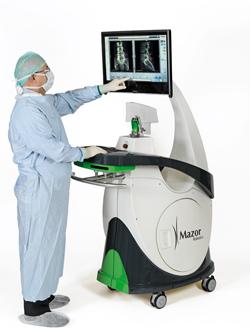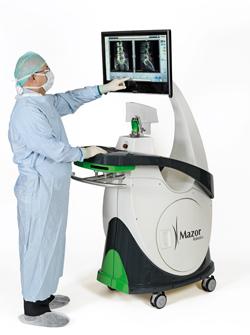Robot-Guided Brain Surgery Performed at German Hospital
July 18, 2012

Neurosurgeons at HSK Hospital in Wiesbaden, Germany have used Mazor Robotics' Renaissance spine surgery system to conduct the first robot-guided brain surgery procedures. HSK was one of the first medical centers in the world to begin using robotic technology for spine surgeries. Mazor did not reveal any details about its brain surgery application, or what kind of brain surgery procedures the hospital performed.
Mazor's Renaissance system and its predecessor, SpineAssist, have been used in several thousand spine surgeries, including procedures for scoliosis and other complex spinal deformities, osteotomies, and biopsies. The company says that its technology is also applicable to brain surgery for uses such as biopsies, placements of shunts, and placement of neurostimulation electrodes, such as those used for deep brain stimulation.

About 25,000 brain biopsies are performed in the US every year. About half of surgeons who currently use Mazor's Renaissance and SpineAssist robots for spinal surgeries are neurosurgeons, who often also perform brain surgery. Mazor expects that its spine surgery technology will bring similar benefits to brain surgery as it does to spine surgery: increased patient comfort, improved surgical accuracy, and a less invasive approach. Robotic spine surgery is considered to be especially useful where there are line-of-sight challenges, such as with minimally invasive surgeries or complex anatomy.
The Renaissance system, which has an accuracy of 1mm, functions primarily as a guide for surgical tools and implants. It consists of a workstation, software, a guidance unit, and several mounting options. There are four basic steps to its operation for spine surgery. First, surgeons conduct preoperative planning by uploading the patient's CT scan. Using this, they create a preoperative blueprint of the ideal surgery for that particular patient in a virtual 3D environment. This is usually done on a PC. The robot is then rigidly attached to the patient's spine via a mounting platform. This assures the maximum possible accuracy during surgery.
The 3D surgical blueprint is synchronized with the mounting system using two fluoroscopic images of a fiducial array, somewhat similar to the fiducial arrays used for the same purpose in printing and machine vision. Once that's completed, the operation can begin. (Watch a video showing how it works below.)
The Renaissance system has been cleared in the US and Europe for spinal surgery. Now, regulatory clearance for Mazor's brain surgery application is pending in both regions. When completed, Mazor expects to make the brain application available as an add-on to the Renaissance system in early 2013.
Related posts:
About the Author(s)
You May Also Like



